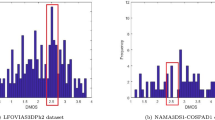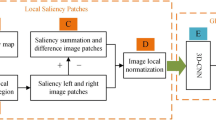Abstract
It has become important to develop an objective stereoscopic image quality assessment (SIQA) method that aligns with human visual system characteristics. To enable an accurate and efficient assessment of stereoscopic image quality, this study introduces a no-reference stereoscopic image quality assessment model, aiming to address the limitations of existing assessment methods. Considering that natural images typically contain information like textures and contours, we decompose stereoscopic views into cartoon and texture images to effectively extract monocular perception features. We also take binocular difference information to explain binocular perception features. Subsequently, a CNN multi-branch architecture is employed to feed images into the network for extracting relevant feature mappings. Finally, all sub-networks are used for quality scoring predictions, resulting in the final perceptual quality score. Experiments conducted on the LIVE dataset have demonstrated the superiority of this approach.
Access this chapter
Tax calculation will be finalised at checkout
Purchases are for personal use only
Similar content being viewed by others
References
Rajagopal, H., et al.: A no-reference image quality assessment metric for wood images. J. Rob. Network. Artif. Life 8(2), 127–133 (2021)
Das, T.K.: Anti-forensics of JPEG compression detection schemes using approximation of DCT coefficients. Multimedia Tools Appl. 77(24), 31835–31854 (2018). https://doi.org/10.1007/s11042-018-6170-7
Voo, K.H.B., Bong, D.B.L.: Quality assessment for stereoscopic images with JPEG compression errors. In: IEEE International Conference Consumer Electronics, pp. 220–221 (2015)
Ibrar-ul Haque, M., Qadri, M.T., Siddiqui, N., Altaf, T.: Combined blockiness, blurriness and white noise distortion meter. Wirel. Pers. Commun. 103(3), 1927–1939 (2018)
Ahmed, I.T., Der, C.S., Hammad, B.T.: Impact of contrast-distorted image on curvelet coefficients. In: 2018 1st Annual International Conference on Information and Sciences (AiCIS), Fallujah, Iraq, pp. 28–32 (2018)
Amor, M.B., Kammoun, F., Masmoudi, N.: A quality evaluation model for calculating block and blur effects generated by H.264 and MPEG2 codecs. Comput. Stan. Interfaces 61, 36–44 (2019)
Li, S., Wang, M.: No-reference stereoscopic image quality assessment based on convolutional neural network with a long-term feature fusion. In: 2020 IEEE International Conference on Visual Communication and Image Processing (VCIP), pp. 318–321 (2020)
Keles, O., Yilmaz, M.A., Tekalp, A.M., Korkmaz, C., Dogan, Z.: On the computation of PSNR for a set of images or video. In: Image Coding Workshop 2021 (PCS), pp. 286–290 (2021)
Sasaki, T., Fukushima, N., Maeda, Y., Sugimoto, K., Kamata, S.I.: Constant-time gaussian filtering for acceleration of structure similarity. In: Sudantha, B. (Ed.), 2020 International Conference on Image Processing and Robotics (ICIPROB) (2020)
Sheikh, H.R., Sabir, M.F., Bovik, A.C.: A statistical evaluation of recent full reference image quality assessment algorithms. IEEE Trans. Image Process. 15(11), 3440–3451 (2006)
Zhao, J., Mao, X., Chen, L.: Learning deep features to recognise speech emotion using merged deep CNN. IET Signal Proc. 12(6), 713–721 (2018)
Yue, G., et al.: Dual-constraint coarse-to-fine network for camouflaged object detection. IEEE Trans. Circuits Syst. Video Technol. 34, 3286–3298 (2023)
Yue, G., Gao, J., Cong, R., Zhou, T., Li, L., Wang, T.: Deep pyramid network for low-light endoscopic image enhancement. IEEE Trans. Circuits Syst. Video Technol. 34, 3834–3845 (2023)
Yue, G.: Specificity-aware federated learning with dynamic feature fusion network for imbalanced medical image classification. IEEE J. Biomed. Health Inform. 99, 1–11 (2023)
Yin, W., Goldfarb, D., Osher, S.: Image cartoon-texture decomposition and feature selection using the total variation regularized L1 functional. In: Paragios, N., Faugeras, O., Chan, T., Schnörr, C. (eds.) VLSM 2005. LNCS, vol. 3752, pp. 73–84. Springer, Heidelberg (2005). https://doi.org/10.1007/11567646_7
Ono, S., Miyata, T., Yamada, I.: Cartoon-texture image decomposition using blockwise low-rank texture characterization. IEEE Trans. Image Process. 23(3), 1128–1142 (2014)
Yin, W., Goldfarb, D., Osher, S.: Total variation based image cartoon-texture decomposition. Columbia Univ. CORC Rep. TR-2005-01, UCLA CAM Rep. 05–27 (2005)
Shi, B., Zhu, C., Li, L., Huang, H.: Cartoon-texture guided network for low-light image enhancement. Digit. Signal Process. 144, 104271 (2024)
Oechsle, M., Mescheder, L., Niemeyer, M., Strauss, T., Geiger, A.: Texture Fields: learning texture representations in function space. In: Proceedings of the IEEE/CVF International Conference on Computer Vision, pp. 4531–4540 (2019)
Gu, K., Zhai, G., Lin, W., Liu, M.: The analysis of image contrast: from quality assessment to automatic enhancement. IEEE Trans. Cybern. 46(1), 284–297 (2016). https://doi.org/10.1109/TCYB.2015.2401732
Gu, K., et al.: Saliency-guided quality assessment of screen content images. IEEE Trans. Multimedia 18(6), 1098–1110 (2016)
Cui, Y., Jiang, G., Yu, M., Chen, Y., Ho, Y.S.: Stitched wide field of view light field image quality assessment: benchmark database and objective metric. IEEE Trans. Multimedia (2023)
Tong, F., Meng, M., Blake, R.: Neural bases of binocular rivalry. Trends Cogn. Sci. 10(11), 502–511 (2006)
Li, L., Li, Y., Wu, J., Ma, L., Fang, Y.: Quality evaluation for image retargeting with instance semantics. IEEE Trans. Multimedia 23, 2757–2769 (2020)
Ma, L., Wang, X., Liu, Q., Ngan, K.N.: Reorganized DCT-based image representation for reduced reference stereoscopic image quality assessment. Neurocomputing 215, 21–31 (2016)
Chen, Y., Zhu, K., Huanlin, L.: Blind stereo image quality assessment based on binocular visual characteristics and depth perception. IEEE Access 8, 85760–85771 (2020)
Cheng, G., Lai, P., Gao, D., Han, J.: Class attention network for image recognition. Sci. China Inform. Sci. 66(3), 132105 (2023). https://doi.org/10.1007/s11432-021-3493-7
Tang, J., Wang, J., Hu, J.F.: Predicting human poses via recurrent attention network. Vis. Intel. 1(1), 18 (2023). https://doi.org/10.1007/s44267-023-00020-z
Jinhui, F., Li, S., Chang, Y.: No-reference stereoscopic image quality assessment considering binocular disparity and fusion compensation. In: 2021 International Conference on Visual Communications and Image Processing (VCIP), pp. 1–5. IEEE (2021)
Zhang, D.: Onfocus detection: identifying individual-camera eye contact from unconstrained images. Sci. China Inform. Sci. 65(6), 160101 (2022). https://doi.org/10.1007/s11432-020-3181-9
Wu, T., Duan, F., Chang, L., Lu, K.: Human-object interaction detection via interactive visual-semantic graph learning. Sci. China Inform. Sci. 65(6), 160108 (2022). https://doi.org/10.1007/s11432-021-3427-2
Li, S., Han, X., Zubair, M., Ma, S.: Stereo image quality assessment based on sparse binocular fusion convolution neural network. In: IEEE Visual Communications and Image Processing (VCIP), pp. 1–4. IEEE (2019)
Fang, Y., Yan, J., Liu, X., Wang, J.: Stereoscopic image quality assessment by deep convolutional neural network. J. Vis. Commun. Image Represent. 58, 400–406 (2019)
Shi, Y., Guo, W., Niu, Y., Zhan, J.: No-reference stereoscopic image quality assessment using a multi-task CNN and registered distortion representation. Pattern Recogn. 100, 107168 (2020)
Ding, Y., Li, S., Chang, Y.: Stereoscopic image quality assessment weighted guidance by disparity map using convolutional neural network. In: IEEE Visual Communications and Image Processing (VCIP), pp. 1–4. IEEE (2019)
Yan, J., Fang, Y., Huang, L., Min, X., Yao, Y., Zhai, G.: Blind stereoscopic image quality assessment by deep neural network of multi-level feature fusion. In: 2020 IEEE International Conference on Multimedia and Expo (ICME), pp. 1–6. IEEE (2020)
Si, J., Huang, B., Yang, H., Lin, W., Pan, Z.: A no-reference stereoscopic image quality assessment network based on binocular interaction and fusion mechanisms. IEEE Trans. Image Process. 31, 3066–3080 (2022)
Chen, Y., Zhao, Y., Li, S., Zuo, W., Jia, W., Liu, X.: Blind quality assessment for cartoon images. IEEE Trans. Circuits Syst. Video Technol. 30(9), 3282–3288 (2020). https://doi.org/10.1109/TCSVT.2019.2931589
Chen, H., et al.: Perceptual quality assessment of cartoon images. IEEE Trans. Multimedia 25 140–153 (2023). https://doi.org/10.1109/TMM.2021.3121875
Zhang, F., Roysam, B.: Blind quality metric for multidistortion images based on cartoon and texture decomposition. IEEE Signal Process. Lett. 23(9), 1265–1269 (2016)
Servos, P., Goodale, M.A., Jakobson, L.S.: The role of binocular vision in prehension: a kinematic analysis. Vis. Res. 32(8), 1513–1521 (1992)
Thorpe, S., Fize, D., Marlot, C.: Speed of processing in the human visual system. Nature 381(6582), 520–522 (1996)
Du, B., Du, C., Yu, L.: MEGF-Net: multi-exposure generation and fusion network for vehicle detection under dim light conditions. Vis. Intel. 1(1), 28 (2023). https://doi.org/10.1007/s44267-023-00030-x
Moorthy, A.K., Su, C.-C., Mittal, A., Bovik, A.C.: Subjective evaluation of stereoscopic image quality. Signal Process. Image Commun. 28(8), 870–883 (2013)
Chen, M.-J., Cormack, L.K., Bovik, A.C.: No-reference quality assessment of natural stereopairs. IEEE Trans. Image Process. 22(9), 3379–3391 (2013)
Mei, S., Geng, Y., Hou, J., Du, Q.: Learning hyperspectral images from RGB images via a coarse-to-fine CNN. Sci. China Inform. Sci. 65(5), 1–14 (2021). https://doi.org/10.1007/s11432-020-3102-9
Hu, J., Wang, X., Chai, X., Shao, F., Jiang, Q.: Deep network based stereoscopic image quality assessment via binocular summing and differencing. J. Vis. Commun. Image Representation 82, 103420 (2022). https://doi.org/10.1016/j.jvcir.2021.103420
Messai, O., Chetouani, A., Hachouf, F., Seghir, Z.A.: No-reference stereoscopic image quality predictor using deep features from cyclopean image. Electron. Imaging 33(9), 297-1–297-9 (2021).https://doi.org/10.2352/issn.2470-1173.2021.9.iqsp-297
Si, J., Yang, H., Huang, B., Pan, Z., Su, H.: A full-reference stereoscopic image quality assessment index based on stable aggregation of monocular and binocular visual features. IET Image Process. 15(8), 1629–1643 (2021). https://doi.org/10.1049/ipr2.12132
Messai, O., Hachouf, F., Seghir, Z.A.: Adaboost neural network and cyclopean view for no-reference stereoscopic image quality assessment. Signal Process. Image Commun. 82, 115772 (2020). https://doi.org/10.1016/j.image.2019.115772
Liu, L., Zhang, J., Saad, M.A., Huang, H., Bovik, A.C.: Blind S3D image quality prediction using classical and non-classical receptive field models. Signal Process. Image Commun. 87, 115915 (2020)
Jiang, Q., Zhou, W., Chai, X., Yue, G., Shao, F., Chen, Z.: A full-reference stereoscopic image quality measurement via hierarchical deep feature degradation fusion. IEEE Trans. Instrum. Meas. 69(12), 9784–9796 (2020). https://doi.org/10.1109/TIM.2020.3005111
Acknowledgments
This work is supported by Shenyang science and technology plan project under Grant 23–407-3–32, Liaoning Province Natural Science Foundation under Grant 2023-MS-139 and National Natural Science Foundation of China under Grant 61901205.
Author information
Authors and Affiliations
Corresponding authors
Editor information
Editors and Affiliations
Rights and permissions
Copyright information
© 2024 The Author(s), under exclusive license to Springer Nature Singapore Pte Ltd.
About this paper
Cite this paper
Liu, Y., Bai, Y., Wang, Y., Jin, M., Liu, B. (2024). A No-Reference Stereoscopic Image Quality Assessment Based on Cartoon Texture Decomposition and Human Visual System. In: Zhai, G., Zhou, J., Ye, L., Yang, H., An, P., Yang, X. (eds) Digital Multimedia Communications. IFTC 2023. Communications in Computer and Information Science, vol 2067. Springer, Singapore. https://doi.org/10.1007/978-981-97-3626-3_6
Download citation
DOI: https://doi.org/10.1007/978-981-97-3626-3_6
Published:
Publisher Name: Springer, Singapore
Print ISBN: 978-981-97-3625-6
Online ISBN: 978-981-97-3626-3
eBook Packages: Behavioral Science and PsychologyBehavioral Science and Psychology (R0)




